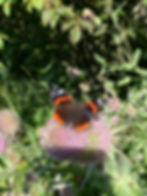Meadow magic
- The Gardener
- Jul 25
- 4 min read
The three swallow chicks have fledged and flown the nest. Time will tell to see if the pair return and produce a second clutch. Some years they’ve done this, others not. Intriguingly and rather randomly, the brood has been returning to the nest from time to time, creating much hullabaloo in the process, while Mum and Dad revert to their former roles of hunter-gatherers. As parents to grown up children, we can only empathise.

The weather this month has been a little mixed. Consistently warm for sure but enough rain to avoid the need for watering the flowerbeds. We’re still continuing to water the pots, of course, but, for the summer bedding, nothing beats the rain. We took the liberty of giving the hybrid tea roses and the raised vegetable boxes a dressing of pelleted chicken manure one day just before the heavens opened, so this should keep the vigour going.

The mid- and late-summer flower pallet continues to emerge. Clumps of Shasta daisies, helipads to hover flies and bees, repeat as you walk around the garden, like daytime torches (which also rather wonderfully fluoresce in the half-light of dusk). The exotic-looking Lobelia tupa with its lipstick red spires vies with the even brighter red of the Maltese Cross, Lychnis chalcedonica. Equally exotic with their dark red foliage, the dahlia ‘Bishop’s Children’ in the late-summer bed have started to bloom, their dark red foliage complementing the dark red of the loftier sunflower ‘Claret’. Peppered amongst them is Verbena bonariensis, a real magnet for hoverflies and comma butterflies.

Pervading the air is that so distinctively sweet aroma of buddleia, this variety ‘Loch Inch’, wafting over the wall from the Drying Green, itself attracting other butterflies - peacocks, red admiral, small tortoiseshell and large white. But the buddleia has further competition in the form of teasel flowers with their explosions of tiny purple flower clusters; we have quite a thicket of these over by the greenhouse and it’s here where most butterflies are to be found, fluttering around and seemingly oblivious to your presence. After last year’s almost complete absence of any insects, Nature has bounced back with a vengeance this year and I don’t think we’ve ever had so many pollinators buzzing around. We’ve certainly never seen so many dragonflies. There’s one hovering over the lily pond at the moment and yesterday evening, one flew over the walled garden, perhaps eyeing up the goldfish pond for its new domain.

Throughout the garden, blue and white agapanthus give a touch of the Mediterranean, picking up on the exotic foliage of the hardy yucca and our young Torbay and Chusan palms. To complete the illusion, our cacti continue to enjoy the post- meridian sun sitting on our west-facing window ledges- outside, not in!

During July and August, the gardener’s tasklist is one of keeping the hoe going, editing out spent blooms, and primping and propping! At the risk of reverting to insect mania once more, after the glut of lupin aphid this spring, probably worse than we’ve ever had it, the garden is now noticeably full of its predator, ladybirds. They are everywhere, proving the point that Nature, while perhaps a little late to the party, is a better controller of insect pests than a sprayer of bug killer.

And there are even ladybirds in the meadow, everywhere, atop tall grasses swaying in the breeze like some kind of exotic circus act! The meadow is an area which requires minimal maintenance but gives maximum reward at this time of the year. Now, we don’t have a wildflower meadow as such. It’s not been seeded with wildflower seed or its growth not slowed by introducing rattle. It is simply a former grass pasture that wraps around the house which, for the last few years, we have allowed to grow, free of livestock, mowing it down just once a year in October/ November.

Access is via a network of mown grass paths, which give plenty space for hares and ground- nesting birds to lurk undetected. At this time of year, though, all the various grass species are flowering, some short, some shoulder-high, with all hues of green, golden and even red. Back-lit in the late-afternoon sun, this is a magical and calming place, and a lovely detox from the HD, full-colour assault of the Walled Garden. It’s taken me a while to come round to using grasses horticulturally but the ones we have in the garden, while very lovely, fail to achieve the impact of those in the meadow. We’re very lucky to be the custodian of this oasis, home as it is to many species of insect, which in turn support our populations of swallow, house-martin and bat. It’s also a thoroughfare for roe deer coming up from the Glen to visit the lily pond for a drink and a passing chew on the low-hanging silver birch.

And finally we made a discovery in the Old Orchard this week, or thought we had! For the first time, our ornamental almond, Prunus dulcis, has produced fruit. However, we got quite excited as our plant identifier app suggested that the tree was an apricot. The fruits bore a strong resemblance for sure, but started to drop off somewhat prematurely. Closer examination, and oddly another ‘go’ with that selfsame app, indicated that the tree was perhaps, after all, an almond! However, this is the first time it’s ever fruited, and we’ve had it for well over 10 years. We’re attributing this to the possible impact of our neighbour’s bees, as the increased fruit-set in the garden overall is noticeable.

